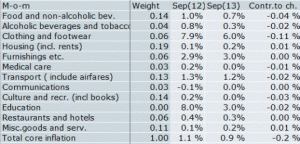Everybody forecast lower inflation
Core inflation rose from 1.4% in June to 2.5% in August surprising everybody including Norges Bank. The big question before the September reading, out October 10 at 10:00 CET, is whether this was the start of a rising trend in inflation. Both consensus, Norges Bank and we do not believe so and forecast core inflation to drop to 2.2% from 2.5% last month.
Norges Bank seems to care less about inflation
Nothing much will happen if we are right. But what if we are wrong? Well, we really do not know how it will influence Norges Bank’s view. Lately inflation different from forecast have had a surprisingly small effect on interest rates compared to its previous reactions (see below). Judging by its earlier “reaction function” core inflation at 0.2 % above forecast (2.4%) would, if it lasted, have a significant effect (+25 bp) on its interest rate path. The bank’s last reaction indicates that inflation must be ½- ¾% points above forecast to have a similar effect.
A downside surprise could have a stronger effect
We are also uncertain how the market will react on surprises. We assume that a higher than expected figure will have some effect, but less than normal, partly because it seems that the previous surprises had so little effect on Norges Bank’s view. However a lower than expected figure could have a stronger effect. There have been a lot of weak key figures from Norway lately and one could argue that high inflation is the one thing that keeps Norges Bank from cutting rates. If we were to get an indication that the spike in inflation was temporary noise we could soon see rate cuts priced in.
A change in the reaction function?
Normally we would have said that inflation 0.2% or more above/below Norges Bank forecast should have a significant impact on interest rates. In a paper from 2012 Norges Bank described a temporary shock lowering inflation and concluded that “nominal rates must be reduced sufficiently to cause the real interest rate to fall”. In other words a say 0.2% points higher inflation should all else equal raise interest rates by at least 25 bp. In the September Monetary Policy Report however Norges Bank says that the 0.9% points higher inflation than forecasted, all else equal, have increased the interest rate by 30 bp compared to the June forecast. If that is the current reaction function 0.2% points higher inflation should have an ignorable effect on the interest rate forecast.
Price growth will dampen somewhat, but not that much.
1/3 of the rise in inflation from June to August is due to a rise in food prices. We see this to a large degree as a permanent rise in in y/y growth due to rising costs. But there is a risk that price growth will rise further due to what seems like years with pressure on margins.
Nearly 0.2% percentage point of the rise in inflation from June to August is however due to higher growth in clothing prices. We believe this reflects an earlier ending of the summer sale this year compared to last year and that price growth will be less strong in September this year than last year. That is the main reason why we forecast core inflation at 2.2% compared to 2.5% last month. Some might argue that the latest NOK weakening will give us higher price growth on clothes. That is true but it is too early to expect such an effect already now.
M-o-m growth and contribution to change in y-o-y
Nordea

